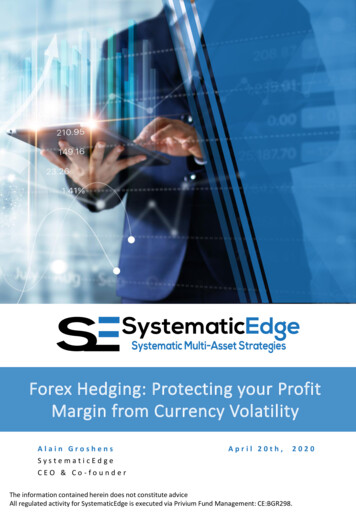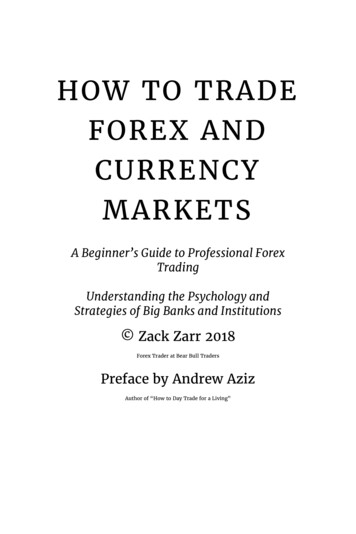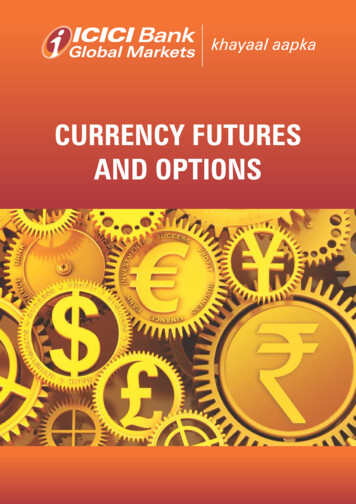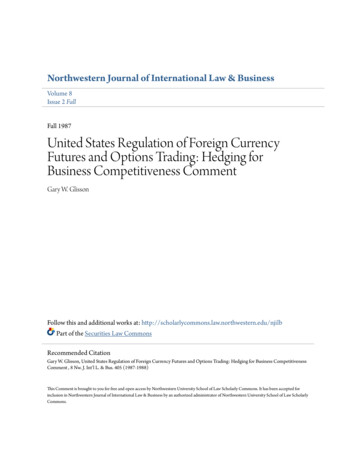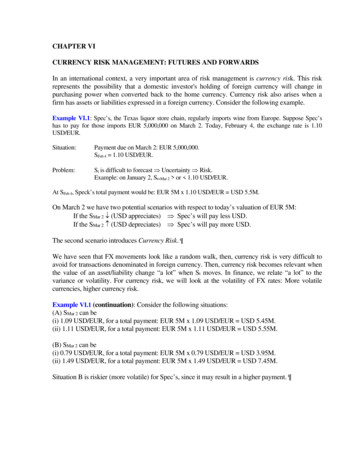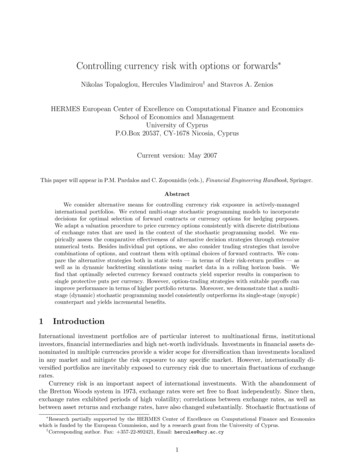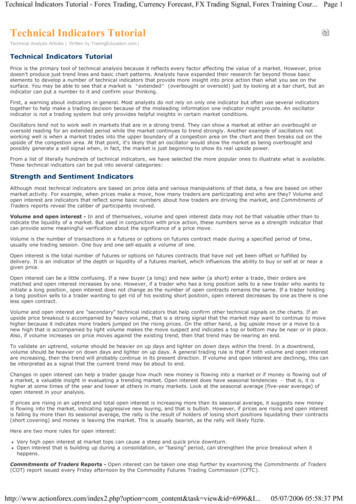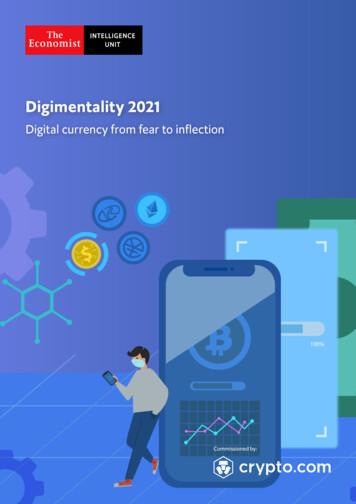
Transcription
Digimentality 2021Digital currency from fear to inflection 100%Commissioned by:
Digimentality 2021Digital currency from fear to inflectionTable of contentsAbout the report1Introduction2Defining digital paymentsPart I: More inflection than fear among consumers35Rise in digital payments6Persistent obstacles8But the tide is turning9Part II: The new gold?14Late to the race, cbdcs lead digital adoption15Diversifying interests18Moving forward21Conclusion22Key takeaways23Appendix 1: Consumer survey demographics25Appendix 2: Institutional survey results27 The Economist Intelligence Unit Limited 20212
Digimentality 2021Digital currency from fear to inflectionAbout the reportDigimentality 2021—Digital currency from fear to inflectionis a report from The Economist Intelligence Unit, commissioned byCrypto.com, exploring the extent to which digital payments are trustedby consumers and what barriers may exist to basic monetary functionsbecoming predominantly electronic or digital. The report compares theattitudes of consumers with a similar survey conducted in 2020 and addsthe perspective of corporate and institutional investors. Kim Andreassonis the author and Jason Wincuinas is the editor of this report.A consumer survey of 3,053 people conducted in February and March2021 provides data for the first part of the report. About half of therespondents came from developed economies (US, UK, France, SouthKorea, Australia and Singapore) and half from developing ones (Brazil,Turkey, Vietnam, South Africa and the Philippines). About seven in tenrespondents were between 18 and 38 years old with the remainingaged 39 years or older. Roughly half (46%) were men and the restwomen (54%). Various educational backgrounds are represented, withthe largest numbers of respondents (five in ten) having a college orprofessional degree. All respondents had bought a product or servicewithin the past 12 months using some kind of digital payment.The second part of the report draws from a survey of 200 institutionalinvestor and corporate treasury management respondents conductedin February, March and April 2021. About a third of respondents areUS-based with the remainder spread across the advanced economiesof Australia, China, France, Germany, Singapore and the UK. All surveytakers were familiar with their organisation’s investment decisionmaking processes.Complete demographics can be found in the appendix.The following executives gave their perspective for the report: Henri Arslanian, crypto leader, PwC Mathew McDermott, managing director and global head of digitalassets, Goldman SachsWe would like to thank all interviewees and survey respondents fortheir time and insight. The Economist Intelligence Unit Limited 20211
Digimentality 2021Digital currency from fear to inflectionIntroductionAcross the world, a move towards cashless societies continues,incorporating a variety of approaches ranging from credit cards andpayment apps to cryptocurrencies and central bank digital currencies(CBDCs). In China, the government has launched a large-scale CBDCpilot with its digital renminbi.1 In the US, the Commodity FuturesTrading Commission unveiled plans for cryptocurrency regulation totake effect by 2024, a development that could accelerate institutionaladoption of digital assets.2 In April 2021 the price of Bitcoin hit an alltime high of more than US 60,000.3“It seems to me that Bitcoin has succeeded in crossing the line frombeing a highly speculative idea that could well not be around in shortorder, to probably being around and probably having some value inthe future,” Ray Dalio, founder of Bridgewater Associates—the world’slargest hedge fund by assets under management—said in a recentresearch note. 4 “The big questions to me are what can it realistically beused for and what amount of demand will it have.”The question of use and demand from a consumer perspective is thefocus of this report’s first section. It explores the extent to which digitalpayments are trusted by consumers and what barriers may exist tobasic monetary functions becoming predominantly electronic or digital,while comparing the attitudes of consumers with a similar surveyconducted in 2020. The second part will address the use and demandquestion on an institutional and corporate level.1 CNBC, “China has given away millions in its digital yuan trials. This is how it works”, n-what-is-it-and-how-does-it-work.html2 CTFC, press release, 203 CNBC, “Bitcoin hits new all-time high above 63,000 ahead of Coinbase e-debut.html4 Bridgewater, “Our thoughts on Bitcoin”, our-thoughts-on-bitcoin The Economist Intelligence Unit Limited 20212
Digimentality 2021Digital currency from fear to inflectionDefining digital paymentsFor the purposes of this report, we use the term “digital payment”to include the following: Online banking (direct payments from a bank account to aperson or business via electronic means instead of a papercheque) Mobile payment or e-wallet (typically via smartphone,including WeChat pay, Alipay, Google Pay, Apple Pay, etc) Online money transfer services (Paypal, Venmo,TransferWise, etc) Open source (non-bank) digital currencies (which includecryptocurrencies such as Bitcoin, Ether, Litecoin, etc) CBDC, which involves digital currency issued as legal tenderby a central bank (such as the Chinese digital yuan or theSwedish e-krona) Corporate-issued digital currencies introduced (sometimescalled a permissioned blockchain, such as Facebook’s Libra/Diem or JP Morgan’s JPM coin) The Economist Intelligence Unit Limited 20213
Digimentality 2021Digital currency from fear to inflection The Economist Intelligence Unit Limited 20214
Digimentality 2021Digital currency from fear to inflectionPart I: More inflection than fearamong consumersConsumers show increasing favour of digital transactions. Those inthe survey further agree that the case for digital currencies and assets,using cryptocurrencies, is especially more compelling (cited by 46%)due to the covid-19 pandemic. Consumer preference for CBDCs (40%)and corporate-issued digital currencies (35%) followed the opensource, or cryptocurrency, option. “It’s a function of continued demandacross both retail and institutions,” says Mathew McDermott, managingdirector and global head of digital assets at Goldman Sachs. “Giventhe huge amount of stimulus we’re seeing across countries because ofcovid-19 and low interest rates, it’s the right place at the right time forcompanies to offer the ability for people to buy, hold, and use digitalcurrencies and have digital wallets.”Figure 1: Consumer barometerConsumers were asked to what extent they agree or disagree that covid-19 heightenedthe use case for digital currencies/assets, by typeSource: The Economist Intelligence Unit The Economist Intelligence Unit Limited 20215
Digimentality 2021Digital currency from fear to inflectionRise in digital paymentsIn the past 12 months, 27% of survey takers reported that they alwaysused digital payments instead of physical banknotes, coins or creditcards. Another four in ten (41%) claimed to use digital payments for atleast half of their purchases. In the 2020 consumer survey, only 22% saidthey always use digital options and 42% said often, indicating an overallyear-over-year rise in digital payments. Further supporting this pointis the 12% that said they rarely used digital payments over the past 12months, which declined from the previous year’s 14%.The most common form of digital currency that consumers reportusing continues to be the open-source variety (cryptocurrencies such asBitcoin), claimed by 18% of survey takers. Government-issued CBDCs(12%) and a digital currency issued by a technology or financial firm(10%) followed. That order of preference has not changed year on year.However, it is worth noting that while announcements of new CBDCshave proliferated in recent months, actual public use is still extremelylimited and primarily in test phases.In terms of awareness, cryptocurrencies remained the most commonlyknown among all digital currency options with more than half (55%) ofconsumers in the 2021 survey saying they are aware of but have neverowned or used a cryptocurrency.“As more people adopt and have access to digital wallets, you canjust see the number who have access and invest in cryptocurrenciescontinues to broaden,” says Mr McDermott. The Economist Intelligence Unit Limited 20216
Digimentality 2021Digital currency from fear to inflection The Economist Intelligence Unit Limited 20217
Digimentality 2021Digital currency from fear to inflectionPersistent obstaclesHabits with physical cash, lack of technological understanding and dataprivacy concerns continue to be the top factors consumers name asbarriers to their country becoming cashless.Figure 2: Habitual obstacleConsumer perception of barriers to their country becoming cashlessSource: The Economist Intelligence UnitThe main barriers towards greater adoption are similar, albeit withnuances, across the different types of digital currencies available. Foropen-source cryptocurrencies, the main barrier is a lack of knowledge,according to survey-takers (cited by 51%). This is followed by securityconcerns (34%) and difficulties knowing where to buy (29%). Greateradoption of CBDCs is hampered by a lack of education (28%), technicalliteracy (27%) and people not trusting that the technology is secure(25%) or concerns over privacy (24%). Similarly, corporate-issued digitalcurrencies suffer from a lack of trust in secure technology (28%), lack ofeducation (25%), concerns over privacy (25%) and technical literacy (24%). The Economist Intelligence Unit Limited 20218
Digimentality 2021Digital currency from fear to inflectionBut the tide is turningNine percent of respondents in the 2021 survey say the country inwhich they live is already cashless (defined as using predominantlydigital instead of physical payment methods), a similar number asthe previous year (10%). However, in 2021 17% said they expect theircountry to become cashless within a year or two, representing a risefrom 14% previously. Indicative of this trend, a fifth (19%) now say theircountry will never become cashless, compared with almost three in ten(28%) in 2020. Uncertainty around the issue also seems to have risenthis year with a slight jump (from 5% to 7%) in respondents saying theydidn’t know. With the speed of development in digital currencies overthe past 12 months, such an outcome perhaps should be anticipated.Figure 3: Rising cashless expectationsConsumer expectations of their country becoming cashlessSource: The Economist Intelligence Unit The Economist Intelligence Unit Limited 20219
Digimentality 2021Digital currency from fear to inflection The Economist Intelligence Unit Limited 202110
Digimentality 2021Digital currency from fear to inflectionThe underlying current towards digital cash continues but appears tobe changing in nature. A year ago, among those who said their countryis already cashless, more than half (55%) believed businesses commandthe most influence on the path to cashlessness, with consumers (24%)and governments (19%) trailing. Perhaps due to growing CBDC coveragein news cycles, governments gained in the influence rating this year,reaching 27%, as did consumers (30%), while the business figure dwindledto 38%. Yet the overall order of influence remains unchanged. While stillholding the most influence, it’s plausible that corporations will pave theway to the point that consumer and government adoption rises enoughthat they carry the cashless trend to a peak, which may be indicative ofprivate sector initiatives from Facebook and JPMorgan, among others.5Figure 4: Cashless influenceConsumer sentiment about groups with the most influence on their countrybecoming cashlessSource: The Economist Intelligence UnitIn 2020 our survey indicated greater resistance to going cashless indeveloped economies versus developed ones. That held true in 2021 atabout the same levels, with respondents in developing nations (Brazil,Turkey, Vietnam, South Africa and the Philippines) generally expressinga higher expectation of using digital payments as opposed to cash formost or all their daily transactions in the next 12 months. Developingnations were also more confident in that outlook, with less than 1%selecting “don’t know” versus 4% in developed nations (US, UK, France,South Korea, Australia and Singapore).5 Bitcoin.com, “Goldman Sachs Cryptocurrency: Possible Collaboration With JPMorgan and -cryptocurrency-jpmorgan-facebook/ The Economist Intelligence Unit Limited 202111
Digimentality 2021Digital currency from fear to inflectionFigure 5: Developing favourLikeliness to switch from physical cash to digital forms of payment for most or all of dailytransactions in the next 12 monthsSource: The Economist Intelligence Unit The Economist Intelligence Unit Limited 202112
Digimentality 2021Digital currency from fear to inflectionFigure 6: Marked difference in understandingConsumer expectations of the major barriers to their country becoming cashlessSource: The Economist Intelligence Unit The Economist Intelligence Unit Limited 202113
Digimentality 2021Digital currency from fear to inflectionPart II: The new gold?Change in the institutional landscape is coming quick. The increasein the price of cryptocurrencies such as Bitcoin has brought renewedinterest from banks, financial services firms and corporate treasuries.For example, in February 2021 Tesla, an electric car company,announced it had brought more than US 1bn in Bitcoin6 into itscorporate treasury and would accept it as a form of payme
26.05.2021 · Online money transfer services (Paypal, Venmo, TransferWise, etc) Open source (non-bank) digital currencies (which include cryptocurrencies such as Bitcoin, Ether, Litecoin, etc) CBDC, which involves digital currency issued as legal tender by a central bank (such as the Chinese digital yuan or the Swedish e-krona) Corporate-issued digital currencies introduced (sometimes called .

![Fear Nothing [039 5.0] By Dean R. Koontz](/img/5/fearnothing.jpg)


